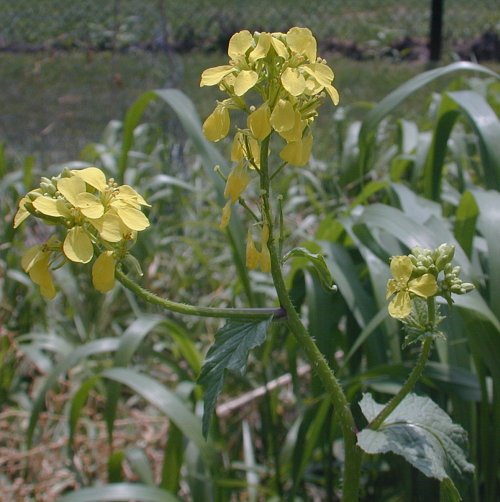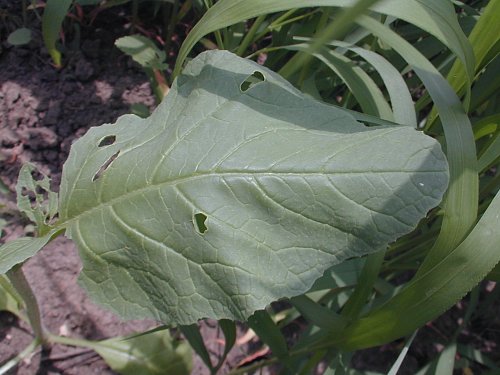Description: This annual plant is 1-3' tall, branching occasionally. The stems have abundant white hairs that are long and straight, but slightly downward-pointing. There is often a reddish purple ring or patch at the junction of a new stem developing from an older stem. This is a distinctive characteristic for this particular species of mustard. The alternate leaves are up to 6" long and 2" across, becoming smaller and more sessile as they ascend the stem(s). Some of the upper leaves may even clasp the stem, while the lower leaves always have petioles. These leaves are highly variable in shape, but are usually ovate, oblanceolate, or obovate. A typical lower leaf is usually broader toward its tip than at the base and somewhat pinnatifid – the terminal lobe is always the largest. The upper leaves have margins that are coarsely dentate and slightly wavy – they are often nearly as broad as long. The hairiness of the leaves is variable, although there are usually a few hairs along their lower mid-veins.

The upper stems terminate in racemes of yellow flowers. These flowers have a typical appearance for members of the Mustard family, except that they are somewhat larger in size, spanning about ½" across. Each flower has 4 yellow petals, 6 stamens, and a single green pistil in the center. The flowers can bloom from late spring to early fall for 1-2 months, with winter annuals blooming earlier than summer annuals. As the flower matures, the petals fall off and the pistil elongates into a narrow seedpod (a silique). This seedpod is about 2/3" (17 mm.) long and tapers into a short beak. A mature seedpod has several fine nerves running along the length of its surface, which is slightly pubescent or hairless. Relative to the flowering stalk, these seedpods are held erect or spread outward, but they do not droop downward. The tiny spherical seeds are dark brown or black. The root system consists of a taproot. This plant spreads by reseeding itself.

Cultivation:
This
plant typically grows in full sun and a mesic fertile soil that
consists of loam or clay-loam, but it will tolerate conditions that
vary from this because of its adaptable, weedy nature. During a hot dry
spell in summer, the leaves often wilt and the size of the plant
becomes stunted. The seeds of this species can remain viable in the
soil for up to 60 years and germinate unexpectedly.
Range & Habitat:
The non-native Wild Mustard occurs occasionally in many counties of
Illinois (see Distribution
Map). It is somewhat more common in northern and central
Illinois than the southern area of the state. It is quite likely that
this species occurs in more counties than official records indicate.
Wild Mustard is adventive from Eurasia and it has existed in the United
States since the 18th century. Habitats include grainfields
(particularly canola or oats), areas along railroads, vacant lots,
gardens, and miscellaneous waste areas. Disturbed areas are strongly
preferred. This species doesn't invade high quality natural areas to
any significant extent.

Faunal
Associations:
Primarily small bees and flies visit the flowers for nectar or pollen.
Occasionally, small White butterflies, Pieris rapae
(Cabbage White) and Pieris protodice (Checkered
White), will visit the flowers for nectar. Similarly, the caterpillars
of the Cabbage White and the Checkered White may feed on the foliage.
The caterpillars of Evergestis pallidata
(Purple-Backed Cabbage Worm Moth) feed on the foliage of both wild and
cultivated mustards. In the Midwest, the oily seeds of Mustards are not
popular with birds – apparently, they are more important as a food
source for birds in California and the Pacific Coast. Occasionally, the
Mourning Dove may eat the seeds. Rabbits eat the leaves of Mustards
occasionally, if the foliage is not too peppery.
Photographic Location:
An abandoned garden at the webmaster's apartment in Urbana, Illinois.

Comments: Wild Mustard can be distinguished from similar Mustard species by the presence of reddish purple rings or patches at the junction of its stems. This species also has long white hairs on its stems, while many other mustards have hairless or pubescent stems. Also, the yellow flowers are rather large and showy for a mustard. A very similar species, Sinapis alba (White Mustard), has leaves that are more slender and pinnatifid, while its seedpods are bristly hairy. Another similar species, Raphanus raphanistrum (Wild Radish), has conspicuous greenish or purplish veins on the petals of its flowers, and its seedpods are divided into conspicuous segments. Other common names for Sinapis arvensis are Charlock and Crunchweed. Similarly, this species has been assigned various scientific names, including Brassica arvensis, Brassica kaber pinnatifida, and others.